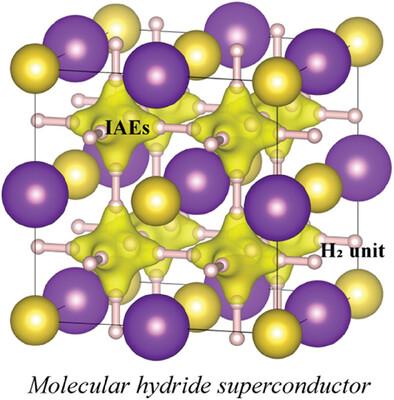当前位置:
X-MOL 学术
›
Adv. Funct. Mater.
›
论文详情
Our official English website, www.x-mol.net, welcomes your
feedback! (Note: you will need to create a separate account there.)
Unlocking the Origin of High-Temperature Superconductivity in Molecular Hydrides at Moderate Pressures
Advanced Functional Materials ( IF 18.5 ) Pub Date : 2024-11-18 , DOI: 10.1002/adfm.202415910 Wendi Zhao, Austin Ellis, Defang Duan, Hongwei Wang, Qiwen Jiang, Mingyang Du, Tian Cui, Maosheng Miao
Advanced Functional Materials ( IF 18.5 ) Pub Date : 2024-11-18 , DOI: 10.1002/adfm.202415910 Wendi Zhao, Austin Ellis, Defang Duan, Hongwei Wang, Qiwen Jiang, Mingyang Du, Tian Cui, Maosheng Miao

|
The current pressing challenge in the field of superconducting hydride research is to lower the stable pressure of such materials for practical applications. Molecular hydrides are usually stable under moderate pressure, but the underlying metallization mechanism remains elusive. Here, the important role of chemical interactions in governing the structures and properties of molecular hydrides is demonstrated. A new mechanism is proposed for obtaining high-temperature and even room-temperature superconductivity in molecular hydrides and report that the ternary hydride NaKH12 hosts Tc values up to 245 K at moderate pressure of 60 GPa. Both the excellent stability and superconductivity of NaKH12 originate from the fact that the localized electrons in the interstitial region of the metal lattice occupying the crystal orbitals well matched with the hydrogen lattice and forming chemical templates to assist the assembly of H2 units. These localized electrons weaken the H─H covalent bonds and improve the charge connectivity between the H2 units, ensuring the strong coupling between electrons and hydrogen-dominated optical phonons. The theory provides a key perspective for understanding the superconductivity of molecular hydrides with various structural motifs, opening the door to obtaining high-temperature superconductors from molecular hydrides at moderate pressures.
中文翻译:

解开中等压力下分子氢化物中高温超导性的起源
目前超导氢化物研究领域的紧迫挑战是降低此类材料的实际应用稳定性压力。分子氢化物通常在中等压力下保持稳定,但潜在的金属化机制仍然难以捉摸。在这里,证明了化学相互作用在控制分子氢化物的结构和性质中的重要作用。提出了一种在分子氢化物中获得高温甚至室温超导性的新机制,并报告了三元氢化物 NaKH12 在 60 GPa 的中等压力下承载高达 245 K 的 Tc 值。NaKH12 优异的稳定性和超导性都源于这样一个事实,即占据晶体轨道的金属晶格间隙区域中的局部电子与氢晶格很好地匹配并形成化学模板以协助 H2 单元的组装。这些局域电子削弱了 H─H 共价键并改善了 H2 单元之间的电荷连接,从而确保了电子和氢主导的光声子之间的强耦合。该理论为理解具有各种结构基序的分子氢化物的超导性提供了一个关键视角,为在中等压力下从分子氢化物获得高温超导体打开了大门。
更新日期:2024-11-18
中文翻译:

解开中等压力下分子氢化物中高温超导性的起源
目前超导氢化物研究领域的紧迫挑战是降低此类材料的实际应用稳定性压力。分子氢化物通常在中等压力下保持稳定,但潜在的金属化机制仍然难以捉摸。在这里,证明了化学相互作用在控制分子氢化物的结构和性质中的重要作用。提出了一种在分子氢化物中获得高温甚至室温超导性的新机制,并报告了三元氢化物 NaKH12 在 60 GPa 的中等压力下承载高达 245 K 的 Tc 值。NaKH12 优异的稳定性和超导性都源于这样一个事实,即占据晶体轨道的金属晶格间隙区域中的局部电子与氢晶格很好地匹配并形成化学模板以协助 H2 单元的组装。这些局域电子削弱了 H─H 共价键并改善了 H2 单元之间的电荷连接,从而确保了电子和氢主导的光声子之间的强耦合。该理论为理解具有各种结构基序的分子氢化物的超导性提供了一个关键视角,为在中等压力下从分子氢化物获得高温超导体打开了大门。


















































 京公网安备 11010802027423号
京公网安备 11010802027423号